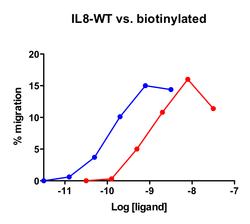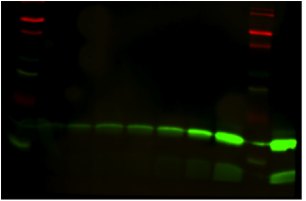Biotinylated Human CXCL8 (IL-8)
|
Stock Sizes: 2ug, 10ug, 50ug, 100ug, and 1mg
Also available in custom sizes, email for a custom quote. |
BACKGROUND
Interleukin 8 (IL-8 )(CXCL8) is secreted primarily by macrophages and monocytes. It is one of the key mediators for inflammatory responses. IL-8 is a strong chemotractant for neutrophils and monoccytes, and promotes activation of these target cells by binding to two cell surface receptors CXCR1 and CXCR2. It is also a strong angiogenic agent, and is considered to play a role in the pathogenesis of bronchiolitis.
Biotinylated CXCL8 is made using the enzymatic method, which has several advantages over chemical biotinylation methods. The attachment of biotin at a specific lysine residue is nearly 100% complete, and leads to a modified chemokine with functionalities comparable to those of the unmodified CXCL8 in migration assay. Utilizing avidin/streptavidin analogues conjugated to various fluorescent labels, biotinylated CXCL8 is useful in studies on receptor identification, distribution, chemokine binding, and other cellular assays. They serve as great tools in visualization and quantification, and can replace radioactively labeled chemokines.
Interleukin 8 (IL-8 )(CXCL8) is secreted primarily by macrophages and monocytes. It is one of the key mediators for inflammatory responses. IL-8 is a strong chemotractant for neutrophils and monoccytes, and promotes activation of these target cells by binding to two cell surface receptors CXCR1 and CXCR2. It is also a strong angiogenic agent, and is considered to play a role in the pathogenesis of bronchiolitis.
Biotinylated CXCL8 is made using the enzymatic method, which has several advantages over chemical biotinylation methods. The attachment of biotin at a specific lysine residue is nearly 100% complete, and leads to a modified chemokine with functionalities comparable to those of the unmodified CXCL8 in migration assay. Utilizing avidin/streptavidin analogues conjugated to various fluorescent labels, biotinylated CXCL8 is useful in studies on receptor identification, distribution, chemokine binding, and other cellular assays. They serve as great tools in visualization and quantification, and can replace radioactively labeled chemokines.
|
SPECIFICATIONS
Source: E. coli derived Accession # P10145-2 (28-99) Modification: Biotin at C-Terminal Formulation: Lyophilized Carrier Protein: None Predicted Molecular Mass: 10,803.49 Da Extinction Coefficient: 12,900 M-1 cm-1 Actual Molecular Mass: 10,803 Da by ESI Mass Spec Endotoxin Level: <0.01 EU per 1μg of the protein by the LAL method Purity: > 97% by SDS PAGE |
PREPARATION AND STORAGE
Reconstitution: Spin sample prior to reconstitution. Recommended at 100μg/mL in sterile water Shipping: Room Temp Stability and Storage: Avoid repeated freeze-thaw cycles • 12 months from date of receipt, -20 to -70 °C as supplied. • ChemoTactics suggests using immediately after reconstitution. • 1 month, -20 to -70 °C under sterile conditions after reconstitution. |
|
Chemokine Induced Migration
Cells expressing recombinant CXCR1 were assayed for migration through the transwell bare filter at various concentrations of IL-8. The response is expressed as the % of total input cells (Blue: wild type; Red: biotinylated). Migration Assay Protocol Activity: EC50 = 0.5-1.0nM determined by migration assay with cells expressing recombinant CXCR1
|
CXCL8-Biotin Detection on PAGE Gel
Detection of various amounts (1-62 ng) of Biotinylated-CXCL8 with streptavidin conjugated to 800CW dye (LiCOR). |
For bulk orders or custom sizes, please contact us and we can provide this for you.
|
|
|
|
|
|
|
REFERENCES
1. “Interleukin-8, a chemotactic and inflammatory cytokine” Baggiolini M., Clark-Lewis I. FEBS Lett. 307:97-101(1992)
2. “Molecular cloning of a human monocyte-derived neutrophil chemotactic factor (MDNCF) and the induction MDNCF mRNA by interleukin 1 and tumor necrosis factor” Matsushima K., Morishita K., Yoshimura T., Lavu S., Kobayashi Y., Lew W., Appella E., Kung H., Leonard E.J., Oppenheim J.J. J. Exp. Med. 167:1883-1893(1988)
3. “Chemokines, CXC|IL-8” Strieter R.M., Keane M.P., Belperio J. A. Encyclopedia of respiratory medicine, Academic Press, Oxford, P395-398(2006)
4. "TSG-6 inhibits neutrophil migration via direct interaction with the chemokine CXCL8." Dyer DP, Thomson JM, Hermant A, Jowitt TA, Handel TM, Proudfoot AE, Day AJ, Milner CM. J Immunol. 2014 Mar 1;192(5):2177-85. Pubmed ID: 24501198
Support: [email protected]
For Research use only, Not for use in Humans.
For Research use only, Not for use in Humans.





